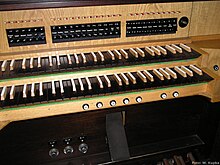Evangelical St. Remigius Church (Dortmund)
The Evangelical St. Remigius Church is located in the Mengede district of Dortmund .
history
The church, built in 1250, has both Gothic and Romanesque features. The typical Westphalian hall church was built as a three-aisled, single-bay church with a transept, choir square and west tower.
The originally Catholic church belonged to the Archdiocese of Cologne . After the church dispute over St. Remigius, the church went to the Protestant church in 1672.
In 1866 the west tower of the church was rebuilt. The southern choir was added around 1900.
In addition to the old St. Remigius Church, which has been Protestant since 1672, there is the Catholic Church of St. Remigius , built in 1876 in the neo-Gothic style, in Mengede .
The namesake of the church is Remigius of Reims .
The church is registered as an architectural monument in the list of monuments of the city of Dortmund .
In the church is u. a. the tomb of the nobleman Matthias von Büren, Herr zu Huckarde and Mengede , as well as his wife Margaretha geb. from Galen . They are the parents of the well-deserved Speyer cathedral dean Gerhard Lothar von Büren († 1660).
organ
The first organ was built in 1690 by the organ builder Alberti (Dortmund). In 1840 the organ builder Kersting (Münster) built an instrument with 18 registers , in 1915 the organ builder Paul Faust built an instrument with 23 registers. The cone shop instrument was rebuilt in 1984 and equipped with a new, free-standing console on the gallery parapet (with a view of the organ). Today it has 22 stops on two manuals (1st main and 2nd swell ) and pedal . The actions are electro-pneumatic.
|
|
|
||||||||||||||||||||||||||||||||||||||||||||||||||||||||||||||||||||||||||||||||||||||||||
- Coupling : I / P, II / P, II / I, Super II / I, Super I / I (normal coupling as register rocker and kick )
- Playing aids : 2 free and 2 fixed combinations (pleno, tutti); Tongue holder; Coupling stop; Rotary control for the tremulant
Bells
Three bells call from the tower for prayer and worship. The smallest bell, the Marienglocke (e ') was cast in 1515 by Johannes von Dortmund and bears the inscription (translated) "My name is Maria. O hear, I call you to the joys of life. I call the living, lament the dead and break the lightning. " Two more bronze bells were cast in 1699 and 1799, but had to be delivered during World War I. As a replacement, two cast steel bells in h ° and d 'were purchased in 1923. They are named Martha and Monika. Unfortunately, the steel bells drown out the bronze bell almost completely.
Web links
- Evangelical parish of St. Remigius Mengede, part of the Noah community
- Mengede - Ev. Church of St. Remigius ( Memento from December 9, 2007 in the Internet Archive )
Individual evidence
- ↑ No. A 0044. List of monuments of the city of Dortmund. (PDF) (No longer available online.) In: dortmund.de - Das Dortmunder Stadtportal. Monument Authority of the City of Dortmund, April 14, 2014, archived from the original on September 15, 2014 ; accessed on June 12, 2014 (size: 180 kB).
- ↑ To the Büren tomb in St. Remigius Mengede
- ↑ Information on disposition
- ↑ Wolfgang Meyer: Ev. St. Remigius Church Mengede . Ed .: Westfälischer Heimatbund. tape 112 . Druckhaus Cramer, Greven 2012, p. 10 .
Coordinates: 51 ° 34 '28.7 " N , 7 ° 23' 6.3" E



